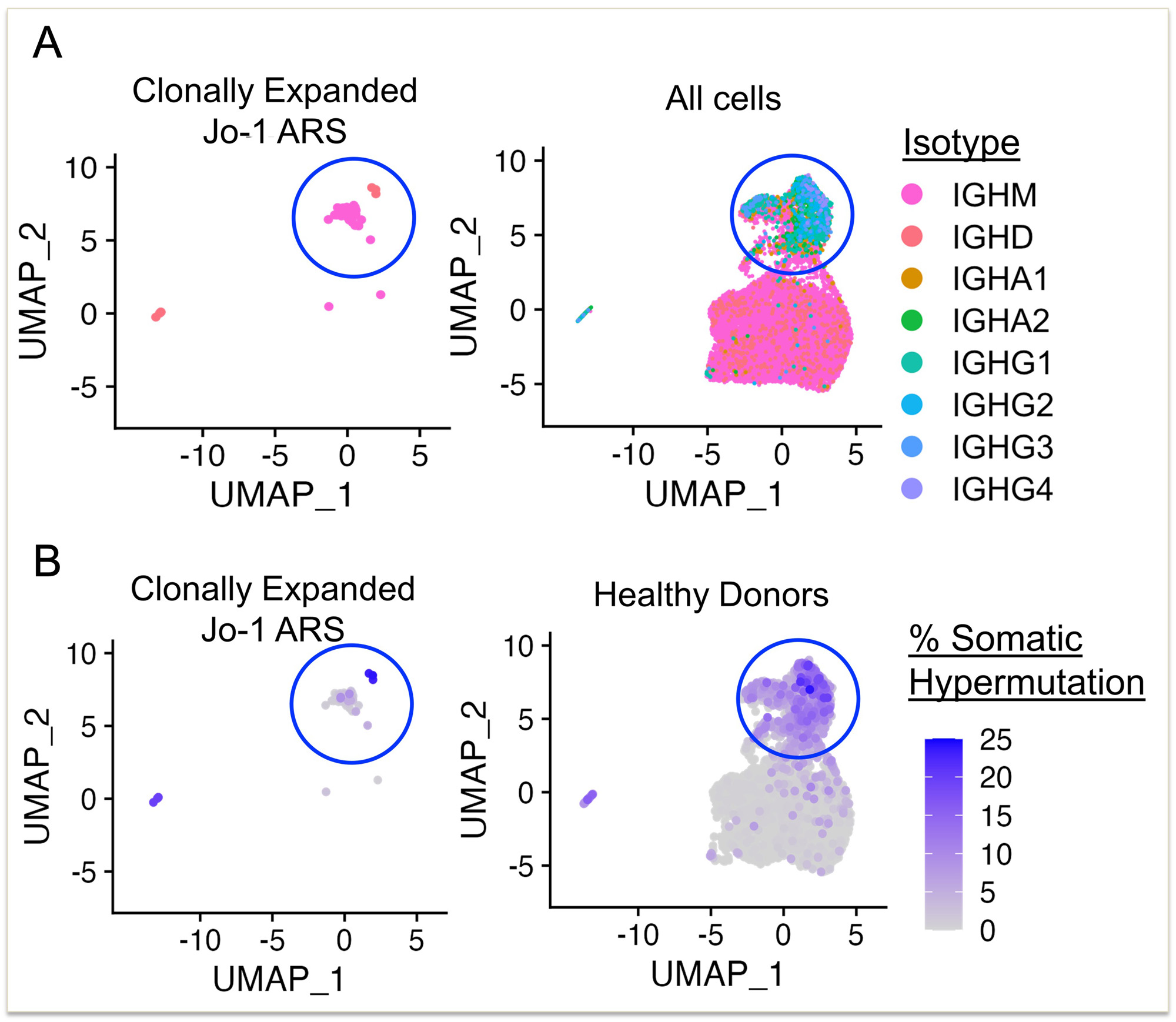Session Information
Date: Tuesday, November 14, 2023
Title: Abstracts: Muscle Biology, Myositis & Myopathies – Basic & Clinical Science I
Session Type: Abstract Session
Session Time: 2:00PM-3:30PM
Background/Purpose: Anti-histidyl-tRNA synthetase syndrome (Jo-1 ARS) is defined by the presence of autoantibodies against histidyl tRNA synthetase (Jo-1). Clinically, Jo-1 ARS can involve multiple tissues including muscle, lung, skin, and joints. Previously, we identified that Jo-1 binding B cells show skewing towards specific phenotypic subsets in the peripheral blood of Jo-1 ARS patients, but the mechanisms that promote B cell recognition of Jo-1 autoantigen are unknown.
Methods: Five patients with active anti-Jo-1 ARS were identified from the Vanderbilt MYSTIC cohort (VUMC IRB 141415). We isolated live CD19+ B cells from cryopreserved peripheral blood mononuclear cells (PBMCs) using fluorescence activated cytometry sorting. Five-thousand cells were targeted for sequencing per sample. Single cell RNA-Seq, V(D)J sequencing, and Cite-Seq were performed using the 10X Chromium platform (5’-RNA, V(D)J, and CITE-Seq) de-multiplexed and processed using the CellRanger pipeline and analyzed with Seurat v4.0.0. V(D)J gene identities and % somatic hypermutation were determined for B cell receptors (BCR) using IMGT/HighV-QUEST. Seurat was used to merge these outputs with RNA-seq and CITE-seq data to enable integrated analysis of BCRs with transcriptomic and phenotypic profiling. Clonally expanded BCRs were identified and recombinantly expressed as monoclonal antibodies. Total IgG, Jo-1, LPS, dsDNA, and insulin binding were measured by ELISA.
Results: Five B cell subsets (transitional, naïve, activated, memory, plasmablast) were assigned based on isotype switching and gene expression (Fig. 1A-B). We identified 21 expanded clonotypes (defined as n ³ 3 per donor) amongst the five donors (Fig. 1C). Clonally expanded cells were CD27+ and CD21lo (Fig. 2) and were primarily IgM+ (non-class-switched) (Fig. 3A). Somatic hypermutation was highly variable and ranged from germline to very high (25%) (Fig. 3B). Recombinant expression of clonally expanded BCRs as IgG1 antibodies and ELISA binding studies revealed that 5/21 (24%) bound Jo-1. All Jo-1 binding clones exhibited some binding of dsDNA, LPS, or insulin, confirming polyreactivity. Multiple Jo-1 binding B cells expressed the VH4-34 heavy chain gene, which has been previously associated with autoimmunity.
Conclusion: Clonally expanded B cells in patients with Jo-1 ARS are enriched for anti-Jo1 B cells, which display an autoreactive-prone (CD21lo) memory phenotype. Somatic hypermutation analysis shows that germline recognition of Jo-1 autoantigen is possible, and that Jo-1-binding B cells can undergo extensive somatic hypermutation. Future studies will be required to determine if somatic hypermutation is associated with affinity maturation of Jo-1-binding B cells, and presumably enhanced pathogenicity.
To cite this abstract in AMA style:
Bass L, Liu D, Cisneros A, Young-Glazer J, Crofford L, Wilfong E, Bonami R. Clonally Expanded B Cells in Anti-Histidyl-tRNA Synthetase Syndrome Patients Exhibit an Autoreactive-Prone Memory Phenotype and Bind Jo-1 Autoantigen [abstract]. Arthritis Rheumatol. 2023; 75 (suppl 9). https://acrabstracts.org/abstract/clonally-expanded-b-cells-in-anti-histidyl-trna-synthetase-syndrome-patients-exhibit-an-autoreactive-prone-memory-phenotype-and-bind-jo-1-autoantigen/. Accessed .« Back to ACR Convergence 2023
ACR Meeting Abstracts - https://acrabstracts.org/abstract/clonally-expanded-b-cells-in-anti-histidyl-trna-synthetase-syndrome-patients-exhibit-an-autoreactive-prone-memory-phenotype-and-bind-jo-1-autoantigen/



